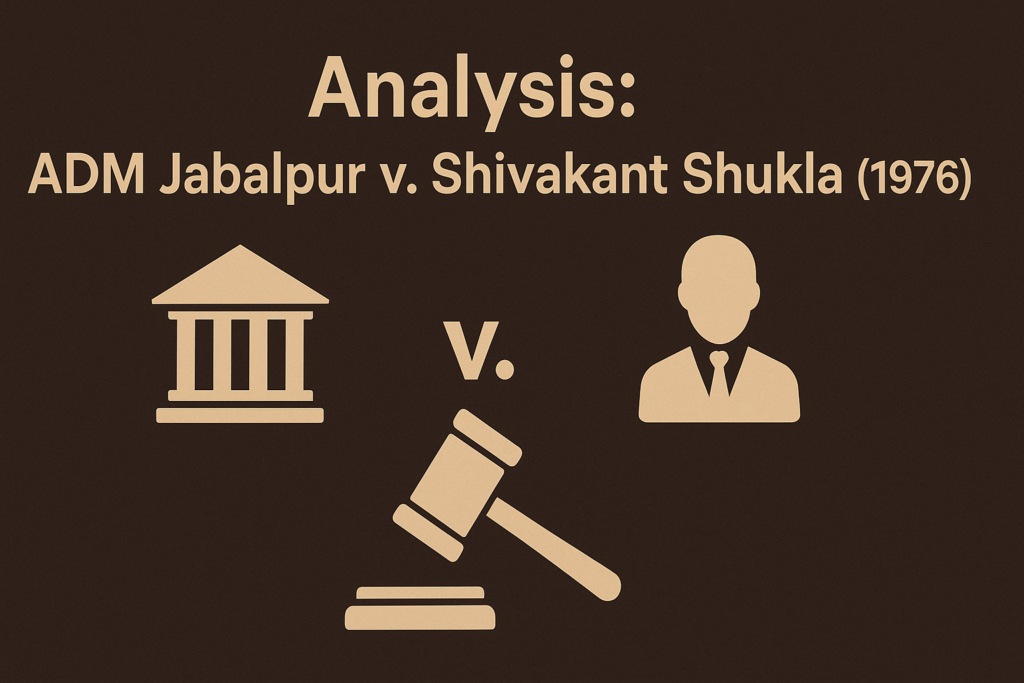
This article has been written by Riddhima Jain, a first-year BBA LL.B. (Hons.) student at Christ University.
- Citation– 1976 AIR 1207, 1976 SCR 172
- Petitioner– Additional District Magistrate (ADM) of Jabalpur
- Respondent– Shivkant Shukla
- Court– Supreme Court of India
- Bench– Constitution Bench (5 Judges)
- Majority Opinion: Chief Justice A. N. Ray, Justice M. H. Beg, Justice Y. V. Chandrachud, Justice P. N. Bhagwati
- Dissenting Opinion: Justice H. R. Khanna
Facts of the Case:-
The origins of this case are rooted in a significant political and legal crisis during the 1970s. On June 12, 1975, the Allahabad High Court, in the case of State of Uttar Pradesh v. Raj Narain, 1975, found Prime Minister Indira Gandhi guilty of electoral malpractice, resulting in the nullification of her Lok Sabha election and disqualification from holding public office for six years. On June 26, 1975, Citing internal unrest, Prime Minister Gandhi advised the President of India, Fakhruddin Ali Ahmed, to declare a state of Emergency under Article 352 of the Constitution. On June 27, 1975 while exercising the powers under Article 359(1), the President issued a proclamation suspending citizens’ right to seek judicial remedies for the enforcement of Articles 14, 21 and 22. This applied to both citizens and non-citizens. On June 29, 1975, the suspension of fundamental rights was extended to Jammu & Kashmir through a subsequent Presidential order. As a result, the government detained several prominent opposition leaders under the Maintenance of Internal Security Act (MISA). A series of amendments and ordinances, including the addition of Section 16A and Section 18, were introduced to MISA, curtailing judicial scrutiny over preventive detentions. The 1975 ordinances authorized the government to detain individuals indefinitely without disclosing the reasons for detention. This crackdown on political opposition led to the filing of multiple writ petitions in various High Courts across the country. Many of these petitions were decided in favor of the detenue. The government, dissatisfied with these outcomes, appealed to the Supreme Court, leading to the infamous case of ADM Jabalpur v. Shivakant Shukla.
Legal Issues:-
The central issues before the Supreme Court was:
- Can a person contesting his wrongful imprisonment maintain the writ of Habeas Corpus in the High Court under Proclamation of Emergency following the President’s order?
- Was Article 21 suspension permissible under the rule of law?
- Does a detainee have locus standi in court during an Emergency?
Arguments: Petitioner (State):-
During a state of emergency, the executive is vested with wide discretionary powers to manage the affairs of the state, as national interest and state security are considered paramount.
The second contention put forth was that even if an Advisory Board finds no adequate justification for a person’s continued detention, the state is not obligated to release the detenue. This continued detention is justified on the grounds of the suspension of Article 22 protections. Moreover, the writ of Habeas Corpus cannot be invoked, even though Article 22 is recognized as a fundamental right.
Additionally, the right to approach a court for enforcement of rights under Article 19 stands suspended under a Presidential Order issued in accordance with Article 359(1). The suspension of the right to move any court for the enforcement of the right to life and personal liberty under Article 21 is a constitutionally sanctioned provision. It cannot be interpreted as a denial of the Rule of Law.
Articles 358, 359(1), and 359(1A), together with other emergency provisions, form part of the constitutional framework. These provisions are deemed essential for safeguarding the country’s military and economic security during times of national crisis.
Arguments: Respondent (Shivakant Shukla):-
The first argument put forth was that Article 359(1) was not intended to entirely strip the legislature of its authority, but rather to permit the making of laws during an Emergency, even if they infringed upon certain fundamental rights, provided such rights were covered by the Presidential Order. The core effect of Article 359(1) was merely to bar individuals from approaching the Supreme Court under Article 32 for the enforcement of the specified fundamental rights. However, this bar did not extend to the jurisdiction of the High Courts under Article 226, which means that the enforcement of common law and statutory rights to personal liberty could still be sought through High Courts.
The validity of the Presidential Order was confined strictly to fundamental rights and did not curtail rights derived from natural law, common law, or statute. Furthermore, the proclamation of Emergency under Article 352 did not amplify the executive powers of the State beyond the limits defined in Article 162 of the Constitution.
It was also contended that Article 21 is not the exclusive source of the right to life and personal liberty. Therefore, even during the operation of the Presidential Order, constitutional rights not classified as fundamental, such as those arising under Articles 256, 265, and 361(3) along with natural rights, contractual obligations, and statutory entitlements, remained unaffected and enforceable.
Regarding preventive detention under the Maintenance of Internal Security Act (MISA), it was argued that state authorities and officials could only detain individuals if the conditions outlined under Section 3 of MISA were fully met. In the absence of such fulfilment, any detention would be deemed ultra vires and beyond the authority conferred by the Act.
Lastly, it was strongly asserted that the Preamble of the Constitution emphasizes India’s identity as a sovereign, democratic, and republican nation. In light of this, the executive, being subordinate to the legislature, should not be allowed to exceed its authority in a manner that infringes upon citizens’ rights. Its actions must remain within the scope of laws validly enacted by the legislature.
Majority Judgment (Delivered on April 28, 1976):-
The majority of the Supreme Court, comprising Chief Justice A.N. Ray and Justices M.H. Beg, Y.V. Chandrachud, and P.N. Bhagwati, ruled in favour of the government. The Court upheld the position that during the emergency, with the suspension of Article 21, a person had no locus standi to approach a court with a habeas corpus petition, even if the detention was illegal or without the authority of law.
Key features of the majority opinion included:
- Suspension of Remedies: The Court ruled that once Article 21 was suspended under Article 359, the right to life and liberty ceased to be enforceable in any court of law. This meant that even if a person was unlawfully detained, the judiciary had no power to interfere.
- Interpretation of Article 359: The bench took a strict and literal interpretation of the constitutional provisions relating to emergency powers. It reasoned that if enforcement of the right was suspended, no person could claim to be deprived of that right in a court of law.
- Emergency as a Constitutional Exception: The judges maintained that the framers of the Constitution had, through Article 359, envisioned a situation where certain rights could be held in abeyance for the greater good. The temporary nature of this suspension was highlighted, suggesting that normalcy would resume post-emergency.
This decision effectively rendered the judiciary powerless in the face of executive detentions and severely limited civil liberties during emergencies.
- Dissenting View: Justice H. R. Khanna:-
Justice Hans Raj Khanna, the lone dissenter, delivered a powerful and courageous judgment that has since become a hallmark of judicial integrity and moral strength.
His dissent rested on the following principles:
- Life and Liberty are Inherent: Justice Khanna emphasized that the right to life and liberty was not something granted by the Constitution but was intrinsic to human existence. Even in the absence of Article 21, the State could not deprive someone of these rights without authority of law.
- Rule of Law: He insisted that no State action could be valid unless it was backed by legal authority. Arbitrary detention, especially without the possibility of judicial scrutiny, was antithetical to the rule of law.
- Judicial Review is Fundamental: Justice Khanna warned against the dangers of unchecked executive power. He asserted that the courts must always retain the power to examine the legality of State actions, especially in matters concerning personal liberty.
- Dangerous Precedent: In his view, upholding the government’s position would lead to a situation where the State could detain individuals indefinitely without explanation or accountability. This, he said, would be equivalent to living under a dictatorship.
Justice Khanna’s dissent cost him the position of Chief Justice, as he was superseded despite being the senior-most judge. However, history has vindicated his stance, and his judgment is widely regarded as a cornerstone of constitutional morality.
Analysis:-
The dissenting opinion of Justice H.R. Khanna in the ADM Jabalpur v. Shivkant Shukla case stands as a monumental expression of judicial integrity and foresight in Indian constitutional history. In a case that arose during the Emergency (1975-77), the majority of the Supreme Court held that even the right to life and personal liberty under Article 21 could be suspended during a proclaimed emergency. This judgment marked a controversial turning point and is widely recognized as a judicial failure to safeguard civil liberties. While the majority succumbed to the pressures of the executive, Justice Khanna stood firm, asserting that no authority, not even the State, can deprive a person of life or liberty without the due process of law, even in times of emergency.
Justice Khanna’s lone dissent became a symbol of judicial courage and independence, especially because he anticipated the personal consequences of his stand. True to his prediction, he was superseded in the appointment of Chief Justice, and his junior, Justice M.H. Beg, was given the post. This move, widely condemned by legal scholars and citizens alike, exposed the erosion of judicial autonomy under political pressure.
The verdict, announced by a majority bench led by Chief Justice A.N. Ray, was received with immense public outrage. Many commentators referred to it as the “darkest day in Indian democracy,” drawing disturbing parallels with the rise of Hitler in Nazi Germany. During the proceedings, when the petitioners’ counsel referenced Hitler’s genocidal regime to caution against absolute executive power, Chief Justice Ray mockingly dismissed the comparison, a reaction that only deepened the public’s disillusionment with the judiciary.
The ADM Jabalpur ruling blatantly failed to uphold the Rule of Law, and rather than protecting the rights of the citizens, it appeared to serve the interests of a few powerful individuals. The only apparent beneficiaries of the judgment were Prime Minister Indira Gandhi, the four judges who supported the government’s stance, and Chief Justice Ray, all of whom, except for Justice Khanna, eventually ascended to the post of Chief Justice of India. In contrast, Justice Khanna resigned in protest after being bypassed, further reinforcing the perception of a compromised judiciary.
In later years, Justice P.N. Bhagwati, who had concurred with the majority in the ADM Jabalpur decision, publicly expressed regret over his judgment. In 2011, he candidly admitted:
“I was wrong. The majority’s decision was incorrect. I would agree with Justice Khanna’s judgment if I could make a new one in that situation. Sorry for any inconvenience this has caused. I am not sure why I caved in to pressure from my co-workers. At first, I was opposed to the general consensus. However, for some reason, I ended up agreeing with them. At the time, I was a rookie judge. This was the first time I had dealt with a case like this. However, it was a sign of my frailty.”
This rare and powerful confession highlights how severely compromised the judicial environment had become during the Emergency and how deep the consequences of that decision ran in Indian legal and political history.
In response to the widespread criticism of ADM Jabalpur, significant constitutional reforms were introduced. One of the most notable was the 44th Constitutional Amendment Act, 1978, which was a direct attempt to undo the legal damage caused during the Emergency. This amendment:
- Guaranteed that Article 21- the right to life and personal liberty can never be suspended, not even during a National Emergency.
- Introduced new procedural safeguards to prevent misuse of preventive detention laws, ensuring that individuals could not be arbitrarily detained without legal recourse.
Furthermore, the landmark judgment in Maneka Gandhi v. Union of India (1978) played a pivotal role in reclaiming constitutional values and restoring public faith in the judiciary. This case overruled key aspects of ADM Jabalpur and expanded the interpretation of Article 21, ensuring that any “procedure established by law” must be just, fair, and reasonable. Importantly, the Court in Maneka Gandhi also linked Articles 14, 19, and 21, asserting that these fundamental rights are not isolated silos, but rather form a coherent and interconnected framework of liberty and equality.
This ruling effectively reversed the narrow and formalistic approach taken in the earlier case of A.K. Gopalan v. State of Madras, where the Court had held that each fundamental right operated independently. Maneka Gandhi clarified that no law could infringe personal liberty unless it satisfied the tests of reasonableness under Articles 14 and 19 as well.
Together, the 44th Amendment and the Maneka Gandhi judgment helped resurrect the essence of constitutional democracy and reinforce the judiciary’s role as a guardian of fundamental rights. These developments were not just legal course corrections, but a powerful societal response to authoritarian overreach, shaped by the lessons of ADM Jabalpur.
The ADM Jabalpur case stands as a painful but critical chapter in Indian constitutional jurisprudence. It reminds us of the fragility of rights during times of crisis, but also of the resilience of democratic principles, when upheld by fearless voices like that of Justice H.R. Khanna. His solitary dissent is today celebrated as a beacon of judicial morality, proving that sometimes, a lone voice of conscience can echo louder through history than the majority’s silence.
Conclusion:-
The ADM Jabalpur v. Shivkant Shukla case remains a landmark case of how constitutional values can be compromised under the guise of national interest. The majority opinion, which validated the suspension of habeas corpus and denied the enforceability of the right to life during emergencies, has been widely condemned by jurists, scholars, and civil society.
In contrast, Justice Khanna’s solitary dissent has stood the test of time, reminding us that the judiciary must always act as the protector of individual freedoms. His words continue to inspire generations of legal thinkers and remain a beacon for constitutional fidelity and human dignity.
The overruling of ADM Jabalpur has not only corrected a historical mistake but also reinforced the idea that no authority, however powerful, can take away the inalienable rights of individuals. It has reaffirmed the central role of the judiciary in upholding the rule of law and defending the principles of justice, especially in times of crisis.
Ultimately, this case illustrates the delicate balance between liberty and security, and the vital importance of preserving that balance in a constitutional democracy like India.






